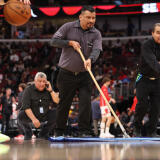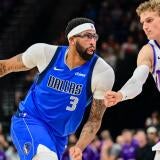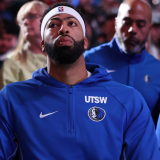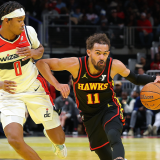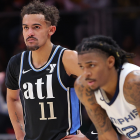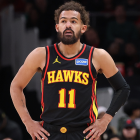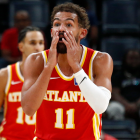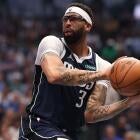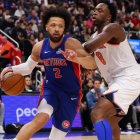
How one of the worst free-throw shooters in NBA is now making freebies consistently
Andre Drummond is making his free throws now, and Pistons coach Stan Van Gundy says this is 'for real'
NEW YORK -- About halfway through the fourth quarter on Saturday, New York Knicks big man Kyle O'Quinn committed a defensive three-second violation, triggering a technical foul. The Detroit Pistons had to choose who would shoot the ensuing free throw, and their best shooter, Reggie Jackson, was on the bench. Pistons coach Stan Van Gundy received a suggestion from his staff that would have been unfathomable months ago: Send Andre Drummond to the line.
Drummond's first five years in the NBA were defined as much by his awful free-throw shooting as his powerful dunks and relentless rebounding. He attempted 1,793 free throws and made 683, for a career mark of 38.1 percent. In 2016, Tom Haberstroh, then of ESPN, published the definitive study of poor free-throw shooting, and used Drummond as the example of what not to do -- the center's approach was extremely inconsistent, even when it came to where he stood horizontally. Opposing teams routinely hacked him, sometimes forcing Van Gundy to send him to the bench.
This preseason, however, Drummond suddenly showed progress, making 16 of his 20 free-throw attempts. Through three regular-season games, Drummond is a perfect 6 for 6 from the line. He has never had a stretch anything like this in his career.
"Look, the sample is small, but you can watch him shoot the free throws and it's for real," Van Gundy said after Detroit's 111-107 win. "I've seen guys, right, they've been bad free-throw shooters and they go 6 for 10 but two of them bank in and the misses were really bad. Even the shots he's missed, so far in the preseason and stuff, everything is soft, everything is on the rim. There hasn't been anything close to a bad miss yet. Like, it's for real. He's going to shoot free throws well. I'm actually hoping somebody will start grabbing him now."
It is difficult to overstate how far Drummond has come. Against the Houston Rockets in January 2016, Drummond shot 13 for 36 from the free-throw line, setting an NBA record for missed free throws in a single game. In one unwatchable stretch, Rockets forward K.J. McDaniels fouled him five times in nine seconds. This in part led to the NBA tweaking its rules on intentional fouls away from the ball before the 2016-17 season.
That summer, the Pistons turned to virtual reality -- in an effort to fix his free-throw problem, Drummond put on a headset and watched himself make free throws repeatedly, from different angles. The franchise had invested in him with a five-year, $130 million contract, so they were going to do whatever they could to make it worthwhile, even if it seems like the idea was inspired by "Black Mirror."
Unfortunately, this did not help: he shot 38.6 percent last season. This past June, Drummond reconnected with trainer Idan Ravin, who had worked with him before the 2012 draft. Together, they changed his form and made it repeatable. According to Ravin, it took "many, many, many weeks and thousands of hours" to find something that worked.
"For me, it's like running now," Drummond said. "It's just second nature. I put the work in, I put the time in over the years. I've done what I was supposed to do this summer to keep myself comfortable to where I don't think about it mentally anymore."
Each time Drummond steps to the line, he bends his knees, extends his arms and dribbles the ball once, then brings it up, straightens his back and releases it. Instead of tucking his elbow in and aiming the shot like he used to, it is more fluid.
There is a change, however, even before he starts his motion. Dr. Christian Marquardt, a German sports psychologist, told Haberstroh that poor free-throw shooters should work on "ramping down" by focusing on their breathing when at the line. Before Drummond bends his knees, he takes a deep breath and relaxes his shoulders.
"For me, it's a number of things that tied into the mental aspect of it," Drummond said. "For me, it was just figuring out a way to calm myself down when I get up there. Slow my breath down. Shoot the same consistent form every time."
Added Ravin, "It's not only just necessarily your free throw form, but it's everything associated with it. It's recalibrating how you think. It's a level of confidence and freedom and assurance and bravery and confronting something that everyone says you're shitty at."
Marquardt also recommended that shooters focus on their process, not the result. Drummond is doing this -- when he misses, he said, he now knows exactly what went wrong.
"It's funny how the game of basketball -- anything in life, let's not even just say basketball -- is confidence," Pistons guard Ish Smith said. "He came in with confidence in camp. Knocked 'em down in camp. Preseason, knocking 'em down. And now, he's knocking 'em down. So I'm proud of him because I went through it in college when I couldn't make free throws, and it's really mental. He broke over that mental barrier, and now he's not missing."
Van Gundy said that Drummond's newfound consistency "changes everything." If this really is sustainable, then the coach no longer has to worry about taking him out of the game in crunch time. It will also make Drummond a much more efficient offensive player -- he has always been a force finishing in the paint, but the scouting report has always been simple: If he has a chance to score, send him to the line.
"It changes his confidence because now he's not afraid to be strong and go at the rim and try to dunk on people or finish through people because he's not afraid of the free-throw line anymore," Detroit forward Anthony Tolliver said. "I think it's going to really change things for us and as of right now, he might be our best free throw shooter."
Tolliver laughed after that, but such a statement is not nearly as crazy as it used to be. Drummond and Jackson are the Pistons' only players to have taken more than one free throw this season without a miss. As for shooting a technical free throw, Van Gundy wants to wait a little bit -- he went with Tobias Harris instead -- but Drummond would love to have the opportunity.
"If I keep doing what I'm supposed to do," Drummond said, "then one of these days I will shoot it."


